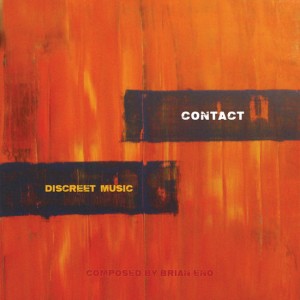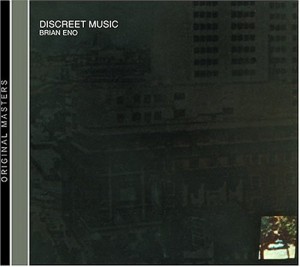The Timelessness of Brian Eno: Contact's Discreet Music
What is it with Brian Eno’s ambient works that make them such beautiful vehicles for acoustic ensembles? Music for Airports and Apollo-Atmospheres and Soundtracks were originally conceived with either loops of overlapping repeating patterns or with mostly electronic instruments, yet both have been magnificently covered by acoustic ensembles, Bang on a Can All-Stars and Icebreaker respectively. Now “Discreet Music,” arguable the first of Eno’s ambient works, has entered the acoustic canon, all of which are on Bang On A Can’s Cantaloupe label.
 On one hand, “Discreet Music” is the least likely work for an acoustic treatment given its roots in tape-loop feedback system Eno created for it in 1975. Playing a couple of short melodic fragments on an EMS Synthi AKS, he ran them through an equalizer, some echoes and into a tape machine. The tape runs to the take-up reel of a second machine and the output of that machine is fed back into the first tape machine which records the overlapped signals ad infinitum. It sounds simple and possibly a little boring, but instead it is a mesmerizing journey: a slow flow down a river of melodic invention.
On one hand, “Discreet Music” is the least likely work for an acoustic treatment given its roots in tape-loop feedback system Eno created for it in 1975. Playing a couple of short melodic fragments on an EMS Synthi AKS, he ran them through an equalizer, some echoes and into a tape machine. The tape runs to the take-up reel of a second machine and the output of that machine is fed back into the first tape machine which records the overlapped signals ad infinitum. It sounds simple and possibly a little boring, but instead it is a mesmerizing journey: a slow flow down a river of melodic invention.
 Vibraphonist Jerry Pergolesi has taken those ensuing melodies and layers upon layers of sound and transposed them to the nine piece group, Contact, from Toronto. It’s an acoustic ensemble of strings, saxophone, electric guitar, double bass, piano, vibes and gongs. I put the CD on in the office and instead of fading into the background, it pulled me into its slowly undulating waves that move like radar slowly scanning the skies. Pergolesi hasn’t created a note-for-note rendition, but an acoustic re imagining that expands the piece out to 60 minutes from its original 31.
Vibraphonist Jerry Pergolesi has taken those ensuing melodies and layers upon layers of sound and transposed them to the nine piece group, Contact, from Toronto. It’s an acoustic ensemble of strings, saxophone, electric guitar, double bass, piano, vibes and gongs. I put the CD on in the office and instead of fading into the background, it pulled me into its slowly undulating waves that move like radar slowly scanning the skies. Pergolesi hasn’t created a note-for-note rendition, but an acoustic re imagining that expands the piece out to 60 minutes from its original 31.
 As “Discreet Music” moves on, the melodies shift from instrument to instrument, sometimes creating counterpoints, echo delays and merging into harmonies in an infinite canon. (Eno’s original Discreet Music album also had a looping rendition of Pachelbel’s “Canon.”) While Eno relied on just a few synthesizer timbres, Pergolesi’ rendition has nine distinctive voices, maybe more if you include the different effects of Rob MacDonald’s electric guitar. This could rob the work of its pristine austerity, but instead, it enhances it, making it even deeper and richer.
As “Discreet Music” moves on, the melodies shift from instrument to instrument, sometimes creating counterpoints, echo delays and merging into harmonies in an infinite canon. (Eno’s original Discreet Music album also had a looping rendition of Pachelbel’s “Canon.”) While Eno relied on just a few synthesizer timbres, Pergolesi’ rendition has nine distinctive voices, maybe more if you include the different effects of Rob MacDonald’s electric guitar. This could rob the work of its pristine austerity, but instead, it enhances it, making it even deeper and richer.
Discreet Music was recorded 40 years ago and Contact’s acoustic rendering is another example of the timeless nature of Brian Eno’s compositions.
~John Diliberto

1 comment for “Brian Eno’s Discreet Music Reborn by Contact.”